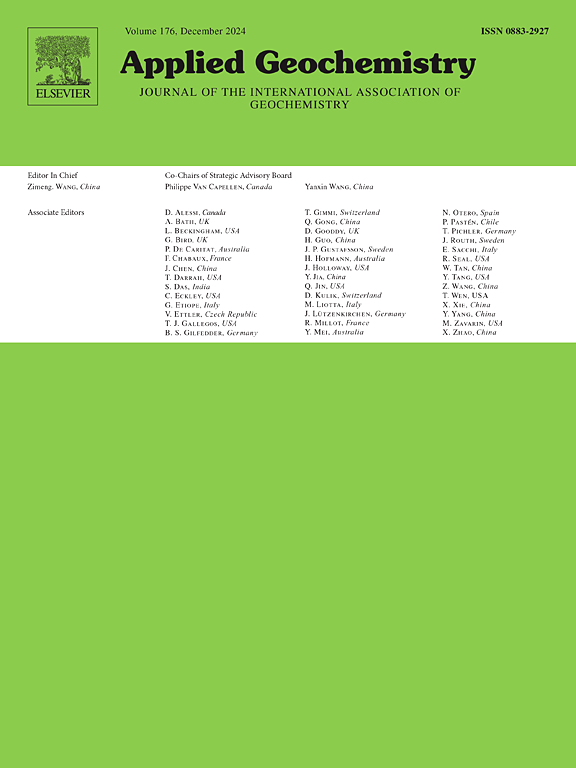Investigation of the key factors favouring the biocementing effect of microbially induced calcite precipitation when applied to mine tailings
IF 3.1
3区 地球科学
Q1 GEOCHEMISTRY & GEOPHYSICS
引用次数: 0
Abstract
Recent research has suggested the applicability of microbially induced calcite precipitation (MICP) to improve wind erosion resistance across diverse media, from clay to sandy soils. While various factors influencing MICP performance have been investigated, comprehensive studies considering the synergistic interactions between biocementation media composition, dosages, available urease activity, and urea-calcium ratios are limited. Consequently, identifying key factors governing MICP during tailings biocementation remains crucial for optimizing treatment strategies. This is specially the case for MICP application for mine tailings biocementation, due to the limited available research dealing with this substrate. This research studied the effect of several factors, when biocementing mine tailings, using a factorial design. The results confirm the key role of the biocementation media dosage and the urea-calcium ratio, and their synergistic interaction during biocementation of tailings, as they determine the calcium and inorganic carbon available to produce calcium precipitates. Biocementation of tailings by applying MICP substantially improved surface strength, leading to a drastic reduction in wind erosion resistance. These results confirm the potential of MICP to become an interesting tool to reduce windblown dust emissions from tailings deposits.
微生物诱导方解石沉淀应用于矿山尾矿中,影响其生物胶结效果的关键因素
最近的研究表明,微生物诱导方解石降水(MICP)适用于提高从粘土到沙质土壤等不同介质的抗风蚀性。虽然已经研究了影响MICP性能的各种因素,但考虑生物胶结介质组成、剂量、可用脲酶活性和脲钙比之间协同相互作用的综合研究有限。因此,确定在尾矿生物胶结过程中控制MICP的关键因素对于优化处理策略至关重要。对于MICP在尾矿生物胶结中的应用尤其如此,因为现有的研究有限。采用因子设计研究了尾矿生物胶凝过程中几个因素的影响。研究结果证实了生物胶结剂用量和脲钙比在尾矿生物胶结过程中的关键作用,以及两者的协同作用,因为它们决定了钙和无机碳可用于产生钙沉淀。通过应用MICP对尾矿进行生物胶结,大大提高了表面强度,从而大大降低了抗风蚀能力。这些结果证实了MICP成为减少尾矿堆积物风吹粉尘排放的有趣工具的潜力。
本文章由计算机程序翻译,如有差异,请以英文原文为准。
求助全文
约1分钟内获得全文
求助全文
来源期刊

Applied Geochemistry
地学-地球化学与地球物理
CiteScore
6.10
自引率
8.80%
发文量
272
审稿时长
65 days
期刊介绍:
Applied Geochemistry is an international journal devoted to publication of original research papers, rapid research communications and selected review papers in geochemistry and urban geochemistry which have some practical application to an aspect of human endeavour, such as the preservation of the environment, health, waste disposal and the search for resources. Papers on applications of inorganic, organic and isotope geochemistry and geochemical processes are therefore welcome provided they meet the main criterion. Spatial and temporal monitoring case studies are only of interest to our international readership if they present new ideas of broad application.
Topics covered include: (1) Environmental geochemistry (including natural and anthropogenic aspects, and protection and remediation strategies); (2) Hydrogeochemistry (surface and groundwater); (3) Medical (urban) geochemistry; (4) The search for energy resources (in particular unconventional oil and gas or emerging metal resources); (5) Energy exploitation (in particular geothermal energy and CCS); (6) Upgrading of energy and mineral resources where there is a direct geochemical application; and (7) Waste disposal, including nuclear waste disposal.
 求助内容:
求助内容: 应助结果提醒方式:
应助结果提醒方式:


